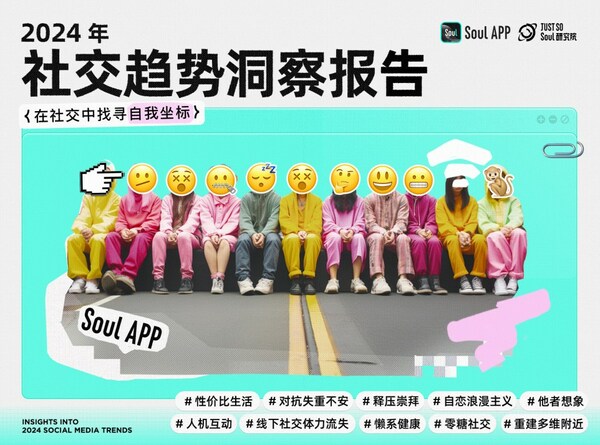Soul App’s Social Trend Keywords 2024: Anchoring “Life Coordinates” to Social Connection

SHANGHAI, Dec. 28, 2023 /PRNewswire/ — 2023 marks a year of fast change, and everyone has to adapt to uncertainty by reconciling their inner self with the outer world. In particular, young people are in a state of influx: they effortlessly transition between introverted and extroverted states; they may feel driven in the morning but emo by the end of the day. When engaging with the world, young Chinese are looking for an answer to who they are before moving forward in life more assuredly.
In other words, Gen Zers strive to reshape their inner state and relationship with the world around them and find their “life coordinates” through social connection. To better understand their quest for identity, Just So Soul, a research arm at Soul App (nearly 80% of its users being Gen Z), conducted a social life survey in December, and collected 3,817 responses, of which about 90% were from Gen-Z users aged 18 to 27.
Considering prevailing trends and its user surveys conducted throughout 2023, Soul has discovered that young people are searching for a sense of belonging from social connection. To establish inner order and set boundaries with others, Gen Zers aren’t afraid to take action to “counterbalance the disorientation of life”, put themselves in the driver’s seat and remove obstacles to building friendships caused by “dwindling interest in offline networking”.
Young people are proactively building social connection in search of a sense of security, while placing an emphasis on self-love and sometimes even “low-dose narcissism as a form of romance”. They detach themselves from reality unwittingly and seek an outlet for stress by “imagining themselves as ‘the other'”, especially power animals.
Gen Zers follow the principle of “deduction” in their social lives, and “pressure-free networking” is their ideal method of engagement. Furthermore, the rise of AIGC enables them to embrace “human-computer interaction”.
As for shopping and leisure, deduction doesn’t mean trading down or settling for something less. Instead, young people pursue a “value for money lifestyle”, “lazy health” and an “escape from stress”.
To compose and control their own life stories, younger generations are “rebuilding a multifaceted ‘nearby'” to anchor their “life coordinates”. These ten keywords will be explored in depth below:
Keyword 1: Counterbalance the Disorientation of Life
Amid multiple conflicting values, young people strive to find their life coordinates in their constant fight against powerlessness and feeling lost.
Only 10% of young people believe that they have “nothing to worry about and live an easy, joyous life”. The majority are plagued with anxiety coming from missing opportunities for professional growth, or feel guilt after relaxing and having fun, leading to “idleness anxiety”.
As young people are enveloped by a shared sense of restlessness, their discussions about “making money” or adopting a “laid-back mindset” as a counterbalance have not gone. At the same time, social connection is gaining greater importance as an emotional outlet, providing individuals with positive feedback.
34.9% of Gen Zers share their concerns with close friends, 28.4% express their anxiety during networking engagements, and 23.5% prefer communicating their thoughts and emotions with peers who have had similar experiences – all higher than the proportion who opens up to their family about life’s concerns.
Keyword 2: Dwindling Interest in Offline Networking
Under a 996 working schedule (9 AM to 9 PM, six days a week), interest in offline networking is declining.
According to Soul’s survey results, 28% of young people said that they “have a chance to make new friends every year”; and 15% “have not made any new friends for a long time”. The decreased friend rate raises a red flag: 24% describe themselves as “a lone ranger” with no friends in whom they can confide; and 15% have only one close friend.
The data highlights an underlying trend that as geographical and kinship ties loosen, digital socializing has become a vital channel for younger generations to break down obstacles to new friendships, with 57.5% of them opting to make friends online.
Keyword 3: Low-dose Narcissism as a Form of Romance
Young people have learned to reparent themselves and accept their imperfections, as said by Oscar Wilde, “To love oneself is the beginning of a lifelong romance”.
Over 90% of young people don’t consider low-dose narcissism to be negative, with 23.7% even endorsing it in the belief that “self-love is a form of romance”.
Psychologically, low-dose narcissism is deemed vital for mental well-being. In the search of life coordinates, self-love has become a foundation for establishing boundaries and a primary principle to interact with the external world.
In their definitions of self-love, young people value caring for health (55.5%), treating themselves well (54.9%), and fostering positive social connections (51.7%).
Keyword 4: Imagining Oneself as the Other
Only when imagining themselves as a monkey, capybara, or mouse can some people show their true selves.
The “self” and “the other” are a set of dichotomous concepts; anything other than the self can be categorized as “the other”, which in a way serves as a valuable reference for self-identity. The right “other” can help people develop a better understanding of themselves.
Social platforms are abuzz with discussions on memes and “Crazy Literature” based on “the other”. In 2023, Soul App witnessed posts related to “monkey literature”, a sort of self-deprecating humor articulated from the perspective of a monkey, and “calm capybara”, a symbol of emotional stability, surge 20 and 13 times, respectively.
Young people enthusiastically seek out a voice or power animal that reflects their identity, be it a monkey, capybara, mouse, or Zhe Ying, a famous impersonator of Chinese singer Na Ying. As if by taking on the persona of the other, they can transform into their “spiritual self”.
Keyword 5: Zero-pressure Social Life
Younger generations crave a sweet, burdenless rush of social connection, like a sugar-free Coke or cake.
The eagerness to find companionship is as strong as ever. More than 90% of young people prefer one-on-one or group social activities to develop friendships. However, the average time spent with friends stands at only 8 hours per week, with 31% of the respondents spending less than 5 hours with friends each week.
To build up their social circles, youngsters are increasingly drawn to zero-pressure, light-hearted interactions. When asked about the ideal state of friendship, 54% favored “both frequent contact with friends and enough alone time”, 18% opted for “communication when they feel like it”, and only 12.6% were “comfortable with seeing friends every day”.
Equipped with an independent mind, young people place a great emphasis on establishing personal boundaries with friends, which justifies the “dazi (buddy search)” trend. Forming friendships is akin to assembling and reassembling LEGO bricks: strangers come together over a shared interest and part ways just as easily, with no hard feelings or strings attached.
Keyword 6: Human-Computer Interaction (HCI)
It’s no longer far-fetched to befriend an AI. This new trend of HCI has helped young people widen their social network.
In 2013, the movie Her, which follows the story of a man developing a tender relationship with an AI virtual assistant, clinched the Academy Award for Best Original Screenplay. 10 years later, thanks to the AIGC boom fueled by tectonic technological breakthroughs, HIC has blossomed from a sci-fi fantasy into multiple real-world applications.
Loneliness, nonetheless, remains a serious problem troubling youth. Just So Soul found that in 2023, 64.5% of young people “sometimes experienced loneliness”, including 33.56% who “almost always felt lonely”.
Alongside friends, hobbies, and family, “virtual humans and idols” (9.1%) have emerged as a preferred form of companionship in moments of loneliness.
Keyword 7: Value for Money Lifestyle
The hashtag #Young consumers are reverse shopping has trended on the Twitter-like Weibo platform, triggering vigorous debate.
“Not that down jackets are too pricey, but military overcoats are just more cost-effective.” “Reverse shopping” is an emerging flight-to-value trend”, which reflects the younger generations’ rethinking on consumerism and the return to a rational consumer mindset.
Topics widely shared by young people include “which brand offers good Bluetooth earphones at an affordable price” and “Is there a value-for-money buffet”. Gen-Z consumers tend to compare prices across platforms and channels before purchasing, and social platforms have become a key channel for them to do research and share tips.
Keyword 8: Lazy Health
The goal is to build the healthiest body possible with the least amount of exercise.
Like the low-dose narcissists, the champions of health believe “caring for health” is most important. However, many young workers struggle to make time to work out in a fast-paced modern life.
Therefore, they choose a lazy approach to health which involves minimal effort: foot baths and sleeping and rising early (36.1%); massages (24.4%); moderate exercise (13.4%); supplements (11.9%).
Keyword 9: Escape from Stress
Overwhelmed by the complexities of life, young people naturally seek instant gratification and various emotional outlets.
Topics like “volunteering at temples” and “meditation at Taoist monasteries” have turned into attention grabbers on social media. In addition, as a source of entertainment, rapid-fire dramas centered around revenge, rags to riches, or dark romance with non-stop plot twists perfectly fit into the fragmented life lived by many young Chinese.
Stress relief enthusiasm has sparked many popular socializing, leisure and shopping phenomena, such as “Crazy Literature”, emotional outpouring through the medium of words, and “brief off-the-grid escapes”, both simple and effective methods used by young people to blow off steam.
Keyword 10: Rebuilding the Multifaceted “Nearby”
Young people are eager to rebuild their nearby relationships in an attempt to gain control of their life.
The “disappearance of the nearby”, a concept proposed by influential anthropologist Xiang Biao, depicts the decline in interaction humans are having with their surroundings amid social atomization. However, based on Just So Soul’s observations, in 2023, young people are starting to rebuild their relationship with the nearby.
They go to a street market or neighborhood park, as part of their effort to bond with the nearby, which, of course, is not limited to in-person interactions. The digital space also provides social scenarios where young people can build a diversified social network, complementing the physical nearby.
In fact, the nearby provides a steering wheel to reestablish control over life, breathing room amid the hustle and bustle, and an anchor which ties to life coordinates.
Heartened by these social trends, Soul App is confident that young people can discover their life coordinates by building meaningful social connections.
SOURCE Soul App





